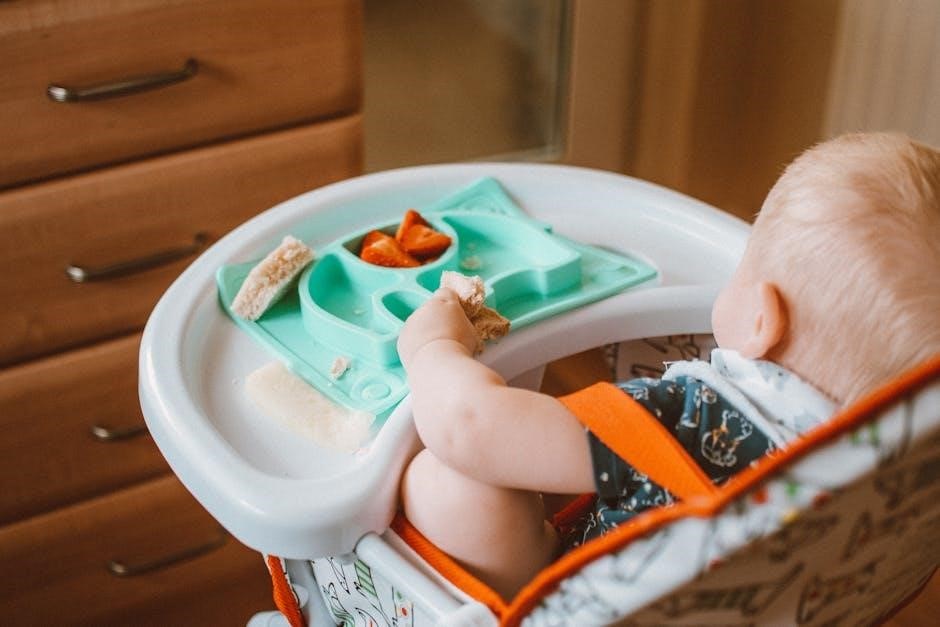Tube feeding at home delivers nutrition directly into the stomach or bowel via a flexible plastic tube, supporting individuals with conditions affecting their ability to eat normally.
1.1 What is Tube Feeding?
Tube feeding, or enteral nutrition, involves delivering liquid nutrition directly into the stomach or small bowel through a flexible plastic tube. It is used for individuals who cannot eat orally due to conditions like swallowing difficulties, severe illnesses, or digestive disorders. The tube can be inserted through the nose (nasogastric) or directly into the stomach or intestine via surgical placement. This method ensures the body receives essential nutrients for proper functioning and overall health.
1.2 Benefits of Tube Feeding at Home
Tube feeding at home offers numerous benefits, including increased comfort, reduced hospital stays, and a more familiar environment for the patient. It allows for personalized nutrition tailored to individual needs, promoting better health outcomes. Caregivers can manage feeding schedules flexibly, reducing stress and ensuring consistency. Home tube feeding also minimizes the risk of hospital-acquired infections and supports a more normal daily routine, enhancing the patient’s quality of life and emotional well-being.
1.3 Who Might Need Tube Feeding?
Tube feeding is essential for individuals who cannot consume food orally due to conditions like dysphagia, severe swallowing difficulties, or neurological disorders. It is also used for those with chronic illnesses, such as cancer or SMA, where eating is challenging. Patients with gastrointestinal disorders or those requiring long-term nutrition support may benefit. Additionally, it supports individuals recovering from surgeries or injuries affecting their ability to eat normally, ensuring they receive proper nutrition for recovery and overall health.

Types of Feeding Tubes
There are three main types of feeding tubes: G-tubes, NG-tubes, and J-tubes. Each serves different needs, from direct stomach access to post-stomach delivery, ensuring tailored nutrition support.
2.1 Gastrostomy Tubes (G-Tubes)
Gastrostomy tubes (G-tubes) are surgically placed directly into the stomach through the abdominal wall, providing long-term nutrition solutions. They reduce the risk of tube displacement compared to NG-tubes. G-tubes are ideal for individuals requiring extended feeding support. The tube is inserted endoscopically or via a small surgical procedure. Caregivers must learn proper usage, cleaning, and maintenance to prevent complications like infections or leakage. Regular medical follow-ups ensure the tube remains functional and comfortable for the user.
2.2 Nasogastric Tubes (NG-Tubes)
Nasogastric tubes (NG-tubes) are inserted through the nose, passing through the esophagus into the stomach. They are typically used for short-term feeding support. NG-tubes are less invasive than G-tubes and can be easily removed when no longer needed. However, they require careful handling to avoid discomfort or complications. Caregivers must learn proper insertion techniques, feeding procedures, and how to secure the tube to prevent dislodgment. Regular monitoring is essential to ensure comfort and safety for the individual using the tube.
2.3 Jejunal Tubes (J-Tubes)
Jejunal tubes (J-tubes) are placed directly into the jejunum, the middle section of the small intestine, bypassing the stomach. They are used for individuals with conditions like severe gastroesophageal reflux or delayed gastric emptying. J-tubes are typically inserted surgically or endoscopically and are designed for long-term use. They reduce the risk of aspiration and ensure nutrients are absorbed effectively. Proper care involves regular flushing, monitoring for blockages, and securing the tube to prevent dislodgment. J-tubes are a reliable option for those requiring direct intestinal nutrition.

Preparing for Tube Feeding at Home
Preparing for tube feeding at home involves setting up a clean, organized space, gathering essential supplies like tubes and formulas, and establishing a feeding schedule.
3;1 Setting Up a Dedicated Feeding Area
Creating a dedicated feeding area ensures a clean, comfortable, and safe environment for tube feeding. Choose a quiet, accessible space with good lighting. Keep all supplies, such as feeding tubes, formulas, and syringes, organized and within reach. Ensure the area is free from distractions and hazards. A dedicated space helps establish a routine, reduces stress, and makes the process more efficient for both caregivers and the individual receiving tube feeding.
3.2 Gathering Essential Supplies
Gathering essential supplies is crucial for successful tube feeding at home. These include feeding tubes, syringes, feeding formula, extension sets, and adapters. Cleaning supplies like mild soap, water, and gauze are also necessary. A feeding pump or gravity bag may be needed, depending on the type of feeding. Keeping a dedicated storage area for these items ensures they remain clean and easily accessible. Having all supplies ready helps streamline the feeding process and reduces stress for caregivers.
3.4 Creating a Feeding Schedule
Creating a feeding schedule is vital for ensuring consistent nutrition and maintaining the health of the individual. The schedule should be tailored to the person’s specific needs, medical recommendations, and lifestyle. It’s important to coordinate with healthcare providers to determine the frequency, volume, and timing of feedings. Using a planner or app can help track feedings and ensure they are administered promptly. Labeling feeding tubes and supplies can also prevent confusion. Regular monitoring and adjustments to the schedule are necessary to meet changing nutritional needs and prevent complications.
The Feeding Process
The feeding process involves preparing the formula, administering it through the tube, and monitoring for comfort and safety to ensure proper nutrition and hydration are maintained.
4.1 Preparing the Formula
Preparing the formula involves mixing the prescribed nutrition with sterile water, ensuring the correct consistency and temperature. Always wash hands thoroughly before handling the formula to prevent contamination. Use a clean, dedicated space for preparation, and avoid cross-contamination by using separate utensils. If using a ready-to-use formula, shake well before opening. For homemade formulas, follow a healthcare provider’s instructions precisely. Never reuse or store mixed formula for extended periods to maintain safety and nutritional value. Always consult with a healthcare provider to confirm the correct formula and preparation method for the individual’s needs.
4.2 Administering the Feeding
Administering the feeding involves carefully delivering the prepared formula through the tube. Always confirm tube placement before starting. For bolus feeding, use a large syringe to slowly push the formula over 10-30 minutes. For continuous feeding, set up an enteral pump according to the manufacturer’s instructions. Monitor the individual for signs of discomfort, such as nausea or pain. Adjust the flow rate as needed and ensure the tube remains clamped when not in use to prevent leakage. Always follow the healthcare provider’s instructions for the feeding method and rate, and keep a record of the feeding schedule and any issues encountered.
4.3 Monitoring for Comfort and Safety
During feeding, monitor for signs of discomfort, such as nausea, pain, or vomiting. Check tube placement regularly and ensure the formula flows smoothly. Watch for complications like leakage or dislodgment. Keep the feeding area clean to prevent infections. Observe the individual’s tolerance to the formula and adjust the rate if needed. After feeding, flush the tube with water to prevent clogging. Document any issues and seek medical advice if concerns arise.
Caring for the Feeding Tube
Proper care ensures the tube functions correctly and prevents complications. Regular cleaning, secure placement, and monitoring for signs of wear or blockages are essential for safe use.
5.1 Cleaning and Maintaining the Tube
Clean the feeding tube regularly with warm water and mild soap to prevent bacterial growth. After each feeding, flush the tube with water to remove residue. Use a soft brush to clean any stubborn blockages. Replace the tube as recommended by your healthcare provider to ensure proper function and prevent infections. Regular maintenance helps extend the life of the tube and ensures safe, effective feeding.
5.2 Securing the Tube Properly
Secure the feeding tube to prevent dislodgment or accidental removal. Use a securement device, such as a tube-securing bracket or tape, to hold it in place. Regularly check the tube’s position by measuring its external length or using verification methods recommended by your healthcare provider. Avoid tight clothing that could put pressure on the tube. Proper securing ensures comfort, safety, and continuity of feeding, reducing the risk of complications. Always follow specific guidance from your healthcare team.
5.3 Checking for Signs of Complications
Regularly monitor for signs of complications, such as infection, leakage, or tube blockages. Look for redness, swelling, or discharge around the tube site. Check for formula leakage, which may indicate improper placement or tube damage. Watch for signs of feeding intolerance, such as nausea, vomiting, or abdominal distension. Ensure the tube remains patent by flushing it as directed. If any concerning symptoms arise, consult your healthcare provider immediately to address potential issues early and prevent serious complications.
Managing Common Challenges
Tube feeding at home can present challenges like clogged tubes, leakage, or emotional struggles. Caregivers must stay vigilant and proactive to address these issues effectively.
6.1 Dealing with Clogged Tubes
Clogged feeding tubes are a common challenge. To address this, flush the tube regularly with warm water and use a syringe to gently clear blockages. If the clog persists, consult a healthcare provider for assistance. Prevent clogs by ensuring the formula is well-mixed and administered slowly. Always check the tube for proper placement before feeding to avoid complications and ensure smooth nutrient delivery.
6.2 Handling Leakage or Dislodgment
Leakage or dislodgment of the feeding tube can lead to complications. If leakage occurs, clean the area thoroughly and secure the tube properly. For dislodgment, immediately stop feeding and consult a healthcare provider. Use a securement device to keep the tube in place and ensure the site is clean to prevent infections. Regular checks can help prevent such issues, ensuring safe and effective tube feeding at home for the patient.
6.3 Addressing Emotional and Psychological Struggles
Tube feeding at home can evoke emotional challenges for both patients and caregivers. Feelings of anxiety, frustration, or embarrassment are common. Open communication and reassurance can help alleviate these emotions. Caregivers should encourage the patient to express their feelings and validate their experiences. Seeking support from healthcare providers, support groups, or counseling services can provide emotional relief and practical guidance. Building a strong support system is key to navigating these challenges effectively and fostering a positive environment for successful tube feeding at home.

Nutrition and Formula Options
Tube feeding involves using specialized formulas tailored to meet nutritional needs. Options include commercial and homemade blends, ensuring proper hydration and balanced nutrition for optimal health.
7.1 Choosing the Right Formula
Choosing the right formula for tube feeding involves considering the individual’s nutritional needs, health conditions, and personal preferences. Commercial formulas are pre-balanced and convenient, while homemade options offer customization. Factors like protein content, calorie density, and hydration levels are critical. Consulting with a healthcare provider ensures the formula meets specific dietary requirements and promotes optimal health outcomes. The formula should be tailored to address any allergies, intolerances, or medical conditions, ensuring safe and effective nutrition delivery.
7.2 Preparing Homemade vs. Commercial Formulas
Preparing homemade formulas allows customization to meet specific dietary needs, but requires precise measurement and safety precautions to avoid contamination. Commercial formulas are pre-mixed, convenient, and ensure balanced nutrition. Homemade options may be more cost-effective but demand careful planning and monitoring. Both methods require strict hygiene practices to prevent infections. It’s essential to consult a healthcare provider before transitioning between formulas to ensure nutritional adequacy and safety for the individual.

7.3 Ensuring Proper Hydration
Proper hydration is crucial for overall health, especially during tube feeding. Caregivers should follow prescribed fluid intake schedules, using water or electrolyte solutions as directed. Monitoring urine output and consistency helps assess hydration levels. Administering fluids separately from nutrition can prevent digestive issues. Regular checks with a healthcare provider ensure the hydration plan is effective and tailored to individual needs, promoting comfort and preventing complications associated with dehydration.

Safety and Prevention
Ensuring safety and prevention in tube feeding is crucial for preventing infections and complications. Use sterile equipment, store supplies properly, and regularly inspect tubes for damage or blockages.
8.1 Preventing Infections
Preventing infections during tube feeding at home requires strict hygiene practices. Always wash hands before handling the tube or formula. Use sterile water for cleaning the tube and surrounding skin. Regularly inspect the insertion site for redness, swelling, or pus, and consult a healthcare provider if any signs of infection appear. Proper storage of feeding supplies in a clean, dry place also helps reduce infection risks. These steps are essential for maintaining a safe feeding environment and protecting the individual’s health. By adhering to these guidelines, caregivers can significantly minimize the risk of infections and ensure a safe tube feeding experience at home.
8.2 Avoiding Accidental Tube Removal
To prevent accidental tube removal, ensure the feeding tube is securely fastened using the provided securing device or a sturdy bracket. Regularly check the tube’s position and tape it firmly to the skin. Avoid pulling or tugging the tube, and educate caregivers and the individual on proper handling. Keep the area clean and dry to prevent irritation. If the tube becomes dislodged, do not attempt to reinsert it yourself; contact a healthcare provider immediately for assistance. This ensures safety and prevents complications.
8.3 Storing Feeding Supplies Safely
Store feeding supplies in a clean, dry, and cool place away from direct sunlight and moisture to prevent degradation. Keep formulas in their original containers and check expiration dates regularly. Use airtight containers for unused supplies to maintain sterility. Ensure all storage areas are out of reach of children and pets to avoid accidental contamination or ingestion. Proper organization and labeling of supplies can also help in quickly identifying what is needed during feeding sessions, ensuring efficiency and safety.
Monitoring and Adjusting
Regularly monitor feeding progress, adjust schedules as needed, and consult healthcare providers to ensure optimal nutrition and address any concerns promptly.
9.1 Tracking Feeding Progress
Regular monitoring of feeding progress is crucial to ensure the patient is receiving adequate nutrition. Track daily intake, weight changes, and overall health improvements. Adjustments may be needed based on these observations to optimize the feeding plan. Keeping detailed records helps in identifying patterns and making informed decisions. Consult with healthcare providers to review progress and make necessary changes for the best outcomes. This ensures the patient’s nutritional needs are consistently met. Accurate tracking also helps in addressing any potential issues early, promoting a smoother feeding process and better health results. Consistency and attention to detail are key to successful monitoring. By maintaining thorough records, caregivers can provide valuable information to healthcare professionals, aiding in personalized care. This collaborative approach ensures the patient receives the most effective support tailored to their specific needs. Regular check-ins with healthcare providers are essential to assess progress and make any required adjustments to the feeding schedule or formula. Through diligent tracking and open communication, caregivers can help patients achieve their nutritional goals and improve their quality of life. Monitoring progress also helps in identifying any adverse reactions or complications early, allowing for timely interventions and maintaining the patient’s well-being. By staying proactive and informed, caregivers play a vital role in the success of tube feeding at home.
9.2 Adjusting the Feeding Plan
Adjusting the feeding plan may be necessary based on the patient’s progress, tolerance, and changing nutritional needs. Regular assessments by healthcare providers can identify the need for formula changes, feeding rate modifications, or tube placement adjustments. Caregivers should monitor for signs of tolerance issues, such as discomfort or digestive problems, and report them promptly. Collaboration with healthcare providers ensures personalized adjustments, optimizing the patient’s nutritional intake and comfort. Open communication and flexibility are key to maintaining an effective feeding plan tailored to the patient’s needs. Adjustments should always be made under professional guidance to avoid complications and ensure the best outcomes.
9.3 Consulting with Healthcare Providers
Regular consultation with healthcare providers is crucial for successful tube feeding at home. They can assess the patient’s progress, address concerns, and make necessary adjustments to the feeding plan. Families and caregivers should attend scheduled check-ups, discuss any changes in the patient’s condition, and ask questions to ensure they are providing the best care. Open communication with healthcare providers helps troubleshoot issues and ensures the feeding plan remains effective and tailored to the patient’s needs. Professional guidance is essential for long-term success.
Tube feeding at home empowers families and caregivers to provide essential nutrition safely and effectively. With proper care, monitoring, and support, successful outcomes are achievable, ensuring comfort and well-being.
10.1 Summary of Key Points
Tube feeding at home involves setting up a dedicated feeding area, using appropriate formulas, and ensuring proper preparation and administration. Monitoring for comfort and safety, along with regular tube maintenance, is crucial. Managing challenges like clogged tubes, leakage, and emotional struggles requires patience and adaptability. Tracking progress and consulting healthcare providers ensures personalized care. Proper hydration, infection prevention, and safe supply storage are essential. By following these steps, caregivers can effectively support their loved ones, promoting well-being and independence.
10.2 Encouragement for Caregivers
Caring for a loved one with a feeding tube can be challenging but incredibly rewarding. Remember, your dedication and patience make a significant difference in their well-being. Seek support from healthcare providers, online resources, or support groups when needed. Celebrate small victories and acknowledge your own efforts. Taking care of yourself is equally important, so prioritize self-care to maintain your strength and resilience. Your role is vital, and your love and commitment are making a lasting impact.
10.3 Final Thoughts on Successful Tube Feeding at Home
Successfully managing tube feeding at home requires commitment, patience, and proper guidance. By following established routines, monitoring progress, and seeking support when needed, caregivers can ensure their loved ones receive the nutrition they need. Celebrate small milestones and remember, your efforts make a significant difference. With time and practice, tube feeding becomes a manageable part of daily life, fostering independence and improving overall health outcomes for both the individual and their caregiver.
